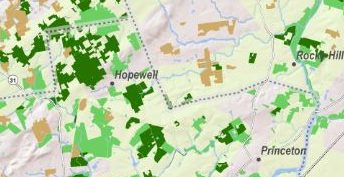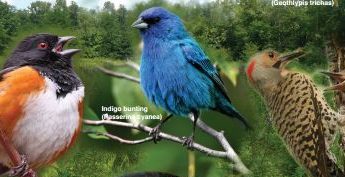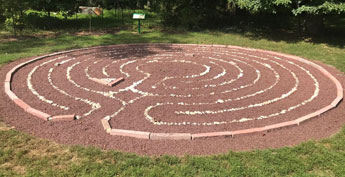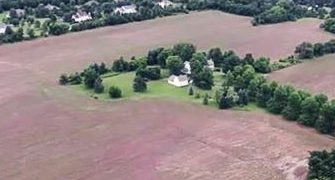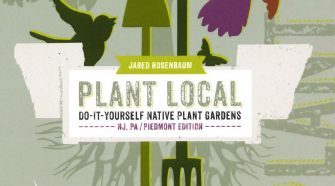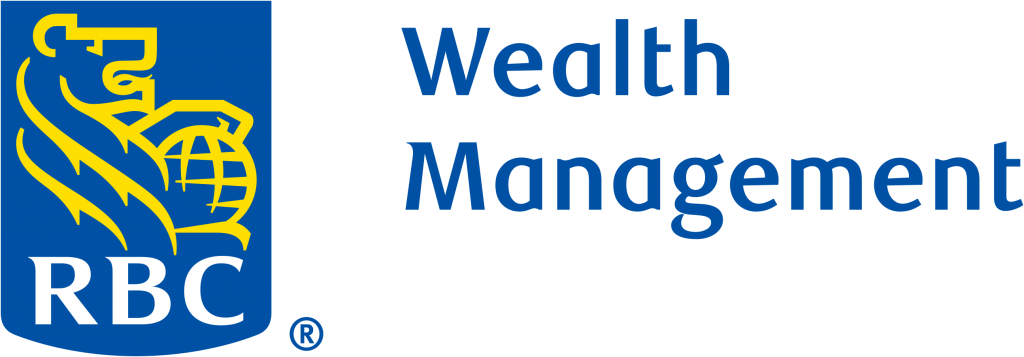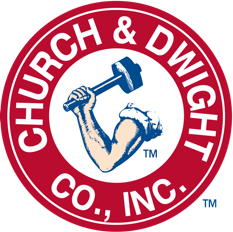By sharing stories–such as the preservation of Matthew’s Farm, above–we hope to bring our mission to life. At D&R Greenway we measure our success by the number of properties, the total acres and the cumulative value of the land we preserve. But we also recognize that preservation isn’t just about statistics. It’s about real people and their land.
Read below to learn about preservation success stories.
 Featured on National Television: Conservation Easement Keeps Historic Estate in Family
Featured on National Television: Conservation Easement Keeps Historic Estate in Family
Read More and watch video
Click here to preview Strange Inheritance episode featuring Meadowtree Farm and land preservation that premiered on national television March 12, 2018
Meadow Tree Farm lies at the foothills of the Sourland Mountain range. The property extends the buffer protecting the Stony Brook and adds to the Stony Brook Greenway.
The farm’s owners, Tim and Sandy Perkins continue to own the farm with the conservation easement. The farm had been owned by Sandy Perkins’s mother since the 1960s; however, over the years both the land and the family home had become rundown and neglected. According to Sandy and Tim, the property was so overgrown, they didn’t even realize it stood upon a small hill. A substantial investment was required to restore the land to a healthy and productive state and renovate the house, so that Sandy and Tim could make the family farm their home.
D&R Greenway worked with Sandy and Tim to customize a preservation solution that would provide the funds to allow Meadow Tree Farm to remain in the Perkins family. This included placing a conservation easement on their property, which will provide significant financial and tax advantages in exchange for retiring the land’s development rights and protecting its natural resources. In addition, the Perkins are combining active farming with wildlife habitat restoration. By participating in a Landowner Incentive Program (LIP), the Perkins will receive ongoing compensation for cultivating fields of native grasses that provide habitat essential to sustain threatened and endangered species of birds.
Meadow Tree Farm lies in the migratory path of hundreds of species of neo-tropical birds who stopover or breed in the Sourlands. “During the spring and fall migrations our meadows and woodlands are covered with birds,” commented Tim Perkins, “and since we planted native grasses a year ago we have seen a marked increase in the number of birds feeding here. The open fields and native plants offer a hospitable environment. The migratory birds are able to observe this landscape as they fly overhead and swoop down to take advantage of it.”
After the spring nesting season the Perkins are able to harvest their native grasslands, generating a cash crop of hay, as well as fodder for their two horses.
The preservation of Meadow Tree Farm offers a replicable model for other “gentleman farmers” throughout central New Jersey. Its structure provides multiple benefits – for the landowner, the community and the natural world. The Perkins receive a financial benefit for preserving their land as permanent open space and for cultivating and maintaining grassland bird habitat. The community benefits from the safeguarding of land, wildlife and the rural heritage of the Princeton- Hopewell-Lawrenceville area. Because Sandy and Tim Perkins also designated 15 easily accessible acres of their farm for use as a public trail network, the community also gains a beautiful natural area to walk and hike through.
According to Linda Mead, “The preservation of Meadow Tree Farm is a perfect example of the kind of “win-win” solution D&R Greenway strives for each and every time we approach a project. This is the best possible outcome – family property remaining in family ownership and the public enjoying the many benefits of protected natural lands. Sandy and Tim Perkins have established a permanent legacy that will strengthen the community in which they live.”
This property includes the 10,000th acre of land preserved by D&R Greenway.

Family Farm Legacy Preserved with Conservation Easement
Read More
Preserving the Schwinn Farm: A Super Human Task
The sheep raise their heads from the lush pasture. Gazing placidly without interrupting their unhurried chewing, they seem to ask,“What’s the rush, silly humans? Grass grows slowly… and it will grow back tomorrow.”
The humans do not have time to consider the sheep’s inquiry. Tomorrow, it will be too late to save the grass.
In four months of frenzied activity between May and September 2017, D&R Greenway’s humans put together a lightning-fast deal to preserve the historic Schwinn farm on Hopewell-Amwell Road in Hopewell Township.
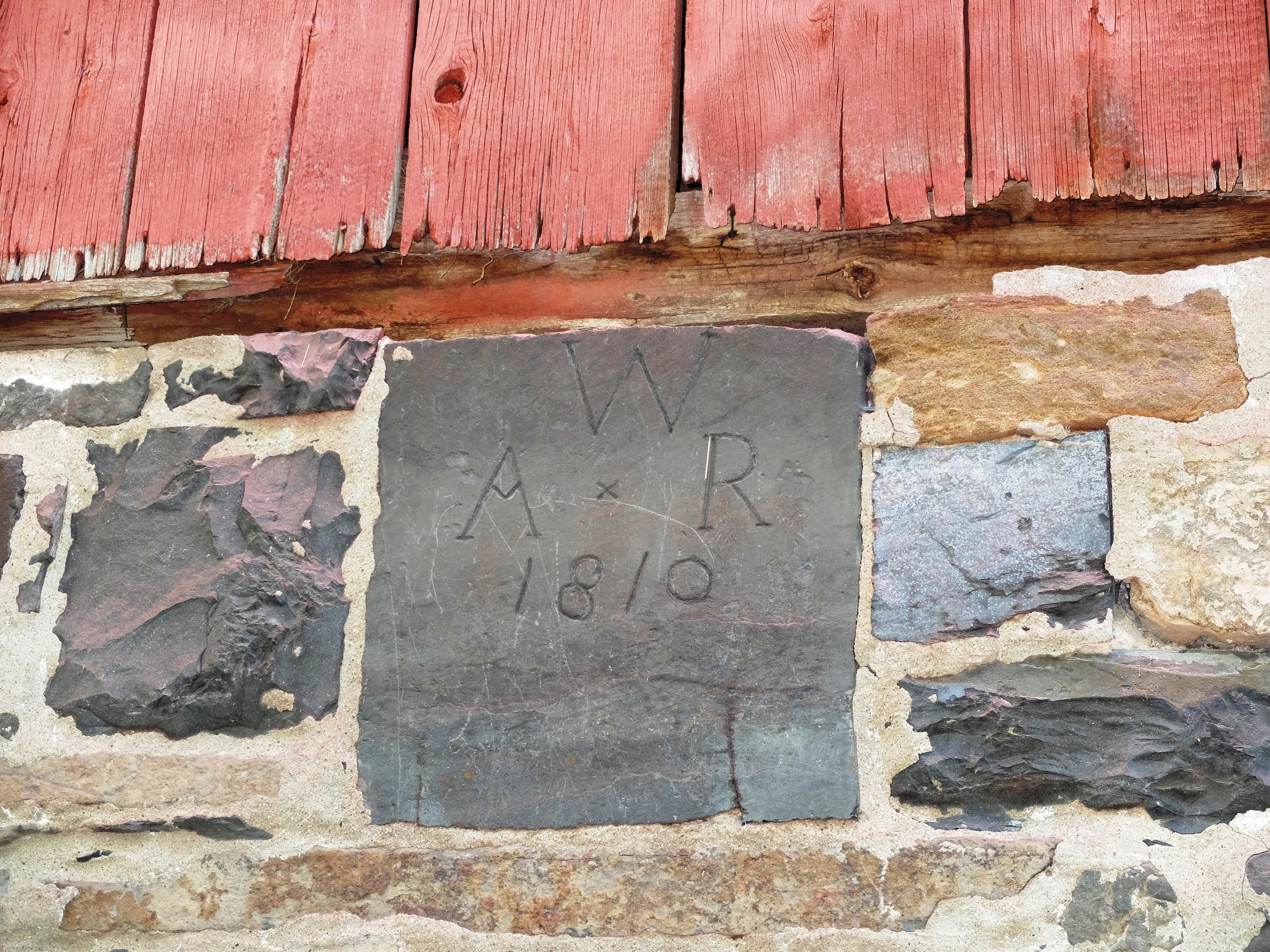 The farm has been in existence since at least the late 18th century. Under its last owners, who worked with D&R Greenway to preserve the farm, it had become home to sheep that grazed the green hillsides. Their lives were immortalized by Ruth Schwinn in two children’s books she authored (Henry the Lamb and Henry and Dale).
The farm has been in existence since at least the late 18th century. Under its last owners, who worked with D&R Greenway to preserve the farm, it had become home to sheep that grazed the green hillsides. Their lives were immortalized by Ruth Schwinn in two children’s books she authored (Henry the Lamb and Henry and Dale).
Now the farm, nearby the historic Lindbergh estate and D&R Greenway’s 700-acre Sourlands Ecosystem Preserve, will be here forever.
Saving the 116-acre property, in the northeast corner of Mercer County, catapulted the total acreage that D&R Greenway has preserved since 1989 to over 20,000 acres. Linda Mead, D&R Greenway’s President & CEO, comments, “Our 20,000th acre was not the easiest one to preserve – but it was one of our most remarkable success stories.”
Augmenting the Sourlands Landscape
The Schwinn farm adds to an extensive mosaic of preserved woods, meadows and farms in Mercer, Hunterdon and Somerset counties: a rural landscape of extraordinary beauty and rich history. It’s a landscape that we “silly humans” can enjoy at our own pace, on two legs. About 20 acres of the Schwinn property will be open to the public, with trails that connect to a large network of protected lands.
The property contains headwaters of the Bedens Brook, in the Millstone River watershed. Its conifer hedgerows provide habitat for roosting owls, and its fields attract foraging butterflies. Contributing to the Sourlands’ 90 square miles of intact woodlands, its mature forest supports vulnerable raptors such as Cooper’s hawk, and migratory neotropical songbirds that depend on these breeding grounds.
Doing the Deal That Had to Get Done
Sandy Schwinn and his brother Gregg grew up on the property, along with a third brother. Sandy, his wife Ruth, Gregg and his wife Pat, co-owned the farm, and wanted to preserve it. But when it came time to retire, with no other family members interested in continuing to farm it, and the two couples moving out of state, the Schwinns needed to sell the farm quickly.
Luckily, the Schwinn family found the perfect preservation partner. With a September 1st deadline looming, and a development-oriented purchaser preparing to swoop in on the property, D&R Greenway rose to the challenge to get the deal done fast. The compressed time frame demanded nimble footwork to get around obstacles to conventional preservation – most significantly the absence of public funds available on short notice.
D&R Greenway brought to the table more than 25 years of expertise in complex transactions, as well as deep connections to preservation-minded individuals in the community. “In a few very short months,” Linda Mead notes, “we were able to identify a conservation buyer and arrange the necessary bridge financing, while accomplishing all the necessary due diligence to protect the property with a conservation easement.”
Ruth Schwinn expresses the family’s gratitude to D&R Greenway: “I am so glad we connected and never gave up. The farm will be a precious part of our heart forever.”
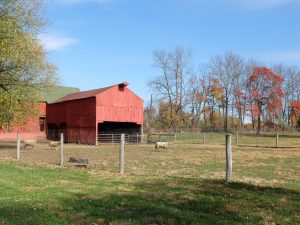 A Farm Embedded in History
A Farm Embedded in History
Ruth explains that preserving the farm means keeping alive the history that is indelibly written onto the property. High on the gable end of its iconic red barn is a stone monogram carved with ‘W/A/R 1810’ indicating that it was built over 200 years ago for Andrew and Rebekah Weart (also spelled Wert). Other “crudely carved handwritten initials and dates” memorialize the lives of families who worked this land over centuries. Deeds for the farm go back prior to 1789. Among the property owners are Stouts (the farm’s first owners), Voorhees and Wyckoffs, all names associated with nearby buildings, roads and villages. Three generations of Conovers later owned the property.
The Schwinn family came into possession of the farm in 1956, one owner removed from the Conovers. Sandy and Gregg’s father, a retired executive, introduced the state’s first pheasant hatchery on the property and called it Pheasant Run Farm. Ruth relates that he also established a business in developing ecologically safe weed suppression products, for which the farm provided nursery stock.
Just south of the property on Province Line Road is the Joseph Stout house (also called Hunt House), used by General George Washington as headquarters to plan for the 1778 Battle of Monmouth.
North of Featherbed Lane was the “Highfields” estate of Charles and Anne Morrow Lindbergh. When the Lindberghs’20-month-old son was kidnapped in March 1932, police scoured the surrounding woods and fields for clues and interviewed neighbors. Harry Conover Jr. and his father, who farmed the property, reported that they had seen a car with doused headlights creeping down Featherbed Lane, while Mrs. Conover heard noises from her hen roosts that she assumed were chicken thieves.
Past, Present and Future on the Schwinn Farm
Ruth Schwinn comments, “When you think about the people who came before us, their blood, sweat and tears shed to preserve themselves, their families and their strongly held beliefs, you cannot help but believe preserving the property was the right thing to do. We want to thank the people who made it happen.”
The farm has new owners now, whose work will continue to mark the land. And the beloved sheep? They’ve moved with Ruth and Sandy. Their spirit, and those of all the other lives well-lived on the Schwinn property, remains, written into earth, forever.
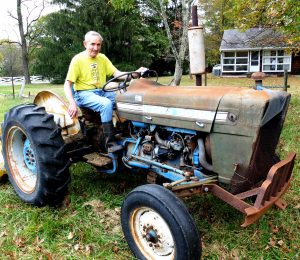 Preservation Enables Couple’s Retirement Goals
Preservation Enables Couple’s Retirement Goals
Read More
The Gift of a Beautiful View Helps One Couple with Retirement Goals
For many years, John and Janet Powell enjoyed looking out their kitchen window onto open fields bordered by trees. They savored the beauty of “the red buds of the maple trees, lit like fire in the sun,” John recalls.
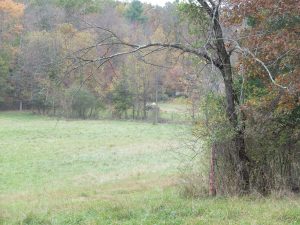 Now, their view has been preserved forever, and it can be enjoyed by everyone. D&R Greenway Land Trust, working with Mercer County through its Open Space Program, has facilitated the preservation of the Powells’ property, two lots along Snowden Lane and Poor Farm Road in Princeton.
Now, their view has been preserved forever, and it can be enjoyed by everyone. D&R Greenway Land Trust, working with Mercer County through its Open Space Program, has facilitated the preservation of the Powells’ property, two lots along Snowden Lane and Poor Farm Road in Princeton.
The site adds 4.3 acres to Mercer County’s Herrontown Woods Preserve: 142 acres of forest that is part of 590 protected acres within the Princeton Ridge Conservation Area. The Princeton Ridge East Conservation Area Partnership (a collaborative land conservation group that includes D&R Greenway, Mercer County, Princeton, Friends of Princeton Open Space, New Jersey Conservation Foundation and Stony Brook-Millstone Watershed Association) works to protect this unique landscape through cooperative stewardship of its biodiversity, and provides public enjoyment of the open space. The partners developed a Stewardship Plan that establishes consistent management principles for the properties independent of ownership.
“As the Powells retired from their farm to their future at Stonebridge, they found that the sale of their land for permanent preservation could meet both their personal and community goals. Their choice for preservation created a legacy that many will enjoy – forever.” Linda J. Mead
From the Powells’ perspective, preservation was the right thing to do “for the neighbors.” Their strong sense of obligation to the community led them to decide that when they moved from the neighborhood, they would leave the neighborhood even better then when they lived there.
John Powell’s relationship with the Princeton Ridge community goes back long before he and Janet bought their house. In the late 1970s John answered a Town Topics help-wanted ad for part-time work—and “the rest is history” John says. He began working with Jac and Cornelia Weller to establish a farm on the south side of Snowden Lane. In the 1990s, John and Janet acquired their property, and they farmed that as well. The beef cattle that grazed the land became a local landmark.
Years later, when John was the executor of the Wellers’ estate, he had the experience of “converting land from private to public use,” as Princeton acquired the Wellers’ property in 2001 to create Barbara Smoyer Park, which supports active recreation. “We grew crops there, and now we grow children—a nice crop too!” chuckles John.
When the Powells decided the time was right to start thinking about retiring to an independent living community, they decided it was also right to preserve the open space surrounding their house. “It’s beautiful, and our neighbors appreciate it too. We wanted it to stay that way.” Through their attorney, Rhinold Ponder, and the Friends of Herrontown Woods, the Powells made a connection to D&R Greenway. “We knew we were working with people we could trust who would stick with the process through the long haul,” says John. A key goal that D&R Greenway assisted with was dividing off the open space lots from the house lot.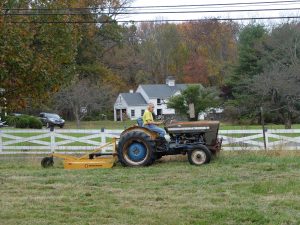
The Powell addition to Herrontown Woods creates the potential to connect Smoyer Park with expansive open space areas, where many miles of trails wind through mature upland forest. South of Herrontown Woods is D&R Greenway’s All Saints’ Preserve; to the north is Princeton’s Autumn Hill Reservation. The three properties are connected by a trail system. Herrontown Woods also includes the historic Veblen House.
For the near term the site will be maintained as open fields. D&R Greenway will steward the Powell properties until the County transfers all of Herrontown Woods, including the Powell additions, to Princeton.
The preservation of their property accomplished the Powells’ goals to leave their beautiful view for the benefit of others. As a bonus, the funds will help with costs of moving to their new community. “It’s other people who made this work,” says John. “The citizens in their foresight wanted the property preserved. And the neighbors are quite happy.”
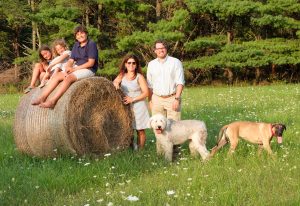 Emily and Johan Firmenich Steward the Future
Emily and Johan Firmenich Steward the Future
Read More
It must have been moonglow. An irresistible force — a magical marriage of love and devotion – drew Emily and Johan Firmenich to preserve an expanse of woods and fields on the outskirts of Princeton.
Mountain View Road in Montgomery Township, Somerset County, is one of those hidden treasures that make visitors gasp, “This is New Jersey!?!” Winding between Bedens Brook and Cherry Run, the road’s uninterrupted vistas of beautiful farmland are a magnet for walkers, cyclists and leisure drivers attracted to a landscape remarkable for its coherence and proximity to Princeton.
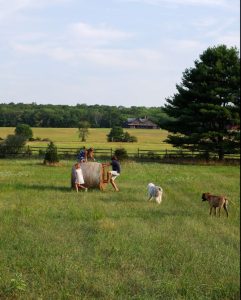 Just as remarkable is that this landscape is now preserved along its entire length. In July, the Firmenichs, working with D&R Greenway, saved the road’s last piece of developable open space.
Just as remarkable is that this landscape is now preserved along its entire length. In July, the Firmenichs, working with D&R Greenway, saved the road’s last piece of developable open space.
It all started on a moonlit night in 2011. “We were living happily in Princeton with our three young children,” Emily recounts. “At D&R Greenway’s Down to Earth Ball at Tusculum, we took a hayride. A full moon lit up the wide open fields and at that moment we knew we wanted to raise our children in a landscape like this.”
Both Firmenichs have vivid childhood memories of rural landscapes, and both are acutely aware of what a community loses when those open spaces are developed. Emily was raised on a farm near Quakertown, Pennsylvania, surrounded by countryside that has since been largely paved over. Johan, who is Project Manager for Sustainability at Firmenich Corporation, grew up in Switzerland, where “Over centuries, most of the land that could be developed was developed.”
When a realtor showed them the balcony of Elizabeth Webster’s property overlooking Mountain View Road, they were awestruck by the view. “Too bad it won’t last”, they said. “Oh, no, the realtor told us – it’s all been preserved,” Emily recalls. “The families before us on this road had the foresight to protect the land. We just fell in love with the place.”
Shortly after they moved, their love was put to the test.
Next to the Firmenichs’ new home was the only unpreserved tract left on Mountain View Road, a 31-acre property of woods and fields. Through Mrs. Webster’s efforts, State Farmland Preservation funds had been allocated for its protection. D&R Greenway alerted the Firmenichs that the time to use these funds was running out. They decided to seize the opportunity to purchase and protect it. “We have a sense of obligation,” Emily says. “It’s a small road that means a lot to many people. It’s a miracle that this road exists, and it would have been a shame to lose it.”
The property is half fields (prime agricultural soils of statewide importance) and half forest. The woodlands, a mixture of deciduous and evergreen trees, support wildlife and protect the Cherry Run stream corridor.
D&R Greenway put together a partnership to preserve the property in conjunction with the Firmenichs’ purchase. The State Agricultural Development Committee (SADC) provided 50% Farmland Preservation funding to Montgomery Friends of Open Space; Montgomery Township and Somerset County each provided 25% match funding.
“I’m so pleased that we received the grant from SADC to help purchase the development rights to this beautiful farm, the hole in the doughnut of preserved farmland on Mountain View Road,” says MFOS President Sarah Roberts.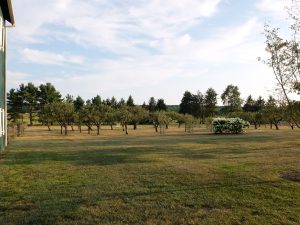
Emily and Johan are now creating a long-term (“30 to 50 years”) management plan for their entire 70-acre property. Emily comments, “We feel more like custodians than owners – we’re carrying the torch, preparing the property for the future the way the people before us did.” They’ll be adding to the stands of native plants (such as milkweed fields that host threatened Monarch butterflies), and will create a tree nursery and native seed bank for the property. Eventually the hay will be replaced with crops that are both financially and environmentally sustainable.
Their son (12) and two daughters (10 and 7) are enjoying the short term, reveling in their new tree houses, “wandering outside, playing in the creek, stalking nature,” says Emily.
Johan, who joined D&R Greenway’s Trustees after the Board’s decision to preserve the property, points out that land trusts also need to plan and fund two distinct programs: preservation to protect land from development, and stewardship to manage protected land so the public can continue to enjoy its benefits. “Land trusts must preserve land while it’s still available. But once we run out of land to preserve, there’s still going to be an enormous amount of work to do, to take care of it. ”
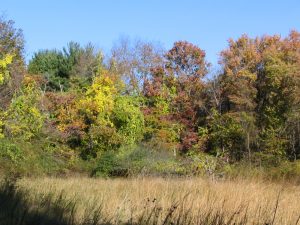 Subdivision Creates Children’s Discovery Trail and Keeps Family Home as Private Residence
Subdivision Creates Children’s Discovery Trail and Keeps Family Home as Private Residence
Read more and watch an inspirational video
At the intersection of Drakes Corner Road and Province Line Road in Princeton is a tranquil woodlot that was Joan and William Roth’s bit of heaven on earth for many years. The Roths lived on this 17 acre property where they enjoyed an active country lifestyle in harmony with their natural surroundings. Avid hikers and observers of wildlife, the Roths spent many happy hours walking the pathways and trails they had established on their property, which linked to the trails of Princeton’s Woodfield Preserve.
As the Roths began to plan for their retirement they decided to move into New York City in order to take full advantage of its many cultural attractions. It was important to them that the land they were leaving behind, that they lived on, cared for and loved for so many years remain unchanged. They also wanted to find a way to share the special qualities of their land with others.
D&R Greenway’s professional staff and technical advisors worked closely with the Roths to devise a solution that enabled them to meet their financial objectives and their desire to keep their property in its natural state. With the assistance of D&R Greenway, the house and five surrounding acres were subdivided from the original property and a conservation easement was placed on that land. This property was subsequently sold to a conservation buyer, with a real estate agent handling the transaction. The remaining 13 acres were sold to D&R Greenway Land Trust in partnership with Friends of Princeton Open Space, through a bargain sale agreement that provided substantial tax benefits to the Roths. Together D&R Greenway and Friends of Princeton Open Space will own and manage this beautiful wooded preserve.
Ultimately, through this preservation agreement the Roths realized both of their goals – achieving the retirement lifestyle they wanted and the permanent protection of their land.
This preservation benefits the residents of three townships – Princeton, Lawrence and Hopewell – in two significant ways. First and foremost, open space and wildlife habitat were protected and the environment and biodiversity of our region was safeguarded. In addition, the property’s location, at the juncture of the three townships, will provide opportunities for linkages into regional trail networks.
The Roths were delighted with the resolution provided by D&R Greenway. According to William Roth, “D&R Greenway made the entire experience as simple and pleasant as possible. Even more important, they helped us keep our beloved property intact. Now, even though we will be based in New York, we can still enjoy walks in “our” woods – and so can all our friends and neighbors.”
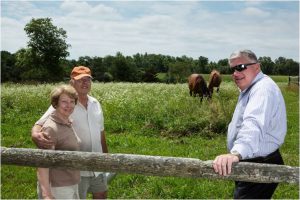 Land Preservation Inspires Healing With Nature
Land Preservation Inspires Healing With Nature
Read more and watch an inspirational video
Edie Howard and her husband, Charlie, preserved their 35-acre farm in Montgomery Township with D&R Greenway Land Trust in 2013. Here, in Edie’s words, is what her preserved land has come to mean to her and her family.
Land is a magical resource. There’s energy in the land and healing in nature.
These thoughts resonated with me when I was given the diagnosis of cancer. It completely startled me: I had been strong and fit, going to the gym four days a week, working out.
Before I could catch my breath, I had surgery. I was looking at a course of chemotherapy that would last 18 weeks.
When you want your body to heal, it’s good to have a vision. I started with a vision of a rainbow which, to me, represented my mother’s love. The rainbow in my mind dissolved into a shower of iridescent colored bubbles.
I had a partner in my husband Charlie. We walked, every day, around the farm field we had preserved with D&R Greenway. Through the four month course of my treatment, we covered 700 miles.
As I was concentrating on the rainbow and the energy the colors were giving me, I could see butterflies and flowers and birds and sunsets and great swaths of green. The Queen Anne’s lace was so thick in the field it looked like a cauldron of bubbles. Bubbles were growing on top of red purple clover that looked like a sea reflecting the sunset. Without that field, my own sense of healing, shared with my four children, nine grandchildren and friends through weekly emails, would have been much less rich.
We managed to get in at least five miles a day, sometimes six or seven, and when I totaled it up at the end I said, “Wow, we’ve walked 700 miles.” Hand-in-hand, all the way.
Edie’s husband Charlie adds this about preserving their land:
“It’s been about three years. So we’ve had 1,000 plus days to think about it. But we don’t think about it, because it was the right decision. The proof is how we feel. Would we have done anything differently? The answer is no. And it’s never going to be different.”

Sale of Farm to D&R Greenway Provides Family Income and Ensures Protection of Grassland Birds
Read More
Maple Lane Farm on Township Line Road in Hillsborough was poised for development. With its 57 acres located just east of Route 206 in the desirable community of Hillsborough, the property could have become yet another suburban subdivision.
The family who had owned the land for many years wanted to see the property remain a farm. They sought a solution that would meet their financial needs while providing for the permanent protection of the land. The landowners were friends of D&R Greenway Trustee Rosemary Blair. When she found out the family wanted to preserve their farm, Mrs. Blair called D&R Greenway to see if an answer could be found.
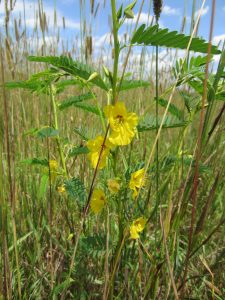 The majority of the property is agricultural land with hedgerows and forested buffer along Pikes Run. The NJDEP Endangered and Nongame Species Program (ENSP) has documented bobolink nesting on the field and meadowlarks have been observed. In the forested areas the ENSP had documented great blue heron. The bobolink is classified as a threatened species and the meadowlark and great blue heron are classified as a species of concern in New Jersey. Declining populations are due, in part, to lack of adequate breeding habitat. Having the ability to preserve New Jersey’s farming heritage while at the same time, protecting imperiled wildlife made preserving Maple Lane Farm an urgent priority.
The majority of the property is agricultural land with hedgerows and forested buffer along Pikes Run. The NJDEP Endangered and Nongame Species Program (ENSP) has documented bobolink nesting on the field and meadowlarks have been observed. In the forested areas the ENSP had documented great blue heron. The bobolink is classified as a threatened species and the meadowlark and great blue heron are classified as a species of concern in New Jersey. Declining populations are due, in part, to lack of adequate breeding habitat. Having the ability to preserve New Jersey’s farming heritage while at the same time, protecting imperiled wildlife made preserving Maple Lane Farm an urgent priority.
The property provides for aquifer recharge and stream corridor and wetlands protection, as well as habitat for woodland species. In addition, the property contributes to an assemblage of 600 acres of preserved farmland.
Working closely with the family, D&R Greenway developed a three-part strategy to finance the preservation of the land while, at the same time, serving the best interests of the public.
Step one was for D&R Greenway to apply, on behalf of the family, to the Somerset County Farmland Preservation Program. Somerset County purchased an agricultural easement on the property for $1,096,699 with grants from three sources: the New Jersey State Agriculture Development Committee; a federal grant from the Farm and Ranch Land Protection Program (FRPP) – administered by the Natural Resources Conservation Service (NRCS) – that was contributed by the New Jersey Conservation Foundation; and county preservation funds. As preserved farmland, Maple Lane Farm will continue to provide a hay crop, and continue to contribute to the local agricultural economy.
Step two was for D&R Greenway to purchase the now deed-restricted Maple Lane Farm and farm the land in a manner that will also enhance and sustain grassland bird habitat. A $199,500 Raritan Piedmont Wildlife Habitat Partnership (RPWHP) grant from Conservation Resources, Inc. allowed for the acquisition. “Preservation of this critical habitat will help ensure that grassland birds will remain a part of the natural heritage of the Central Piedmont area of New Jersey.”
Step three: D&R Greenway manages Maple Lane Farm as a model for the agricultural and conservation communities. The property will serve as a demonstration site showing how farmland and wildlife management can complement each other.
Madelyn Bergen Belliveau, the family member who worked with D&R Greenway to save Maple Lane Farm attests, “The family of John Van Dyke and Blanche Mertz Berger are proud that Maple Lane Farm will remain undeveloped.”
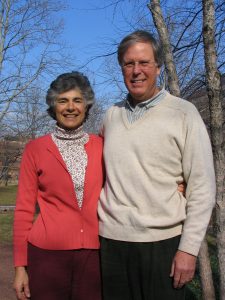
Couple Protects Their Land in Commitment to Sustainability
Read More
A Passion for Preservation
An environmental consciousness and abiding respect for the land infuses every aspect of Stephanie and Bob Harris’ life. Stephanie is a founding member and currently vice-president of the Northeast Organic Farming Association of New Jersey, while Bob helped found a company that specializes in hazardous waste abatement and clean-up. That’s why preserving their 18-acre property, located in the foothills of the Sourland Mountains, became a priority for them. Their energy-efficient house features both passive and active solar collectors.
Their land is situated among eight adjacent preserved properties on the south edge of the Sourland Greenway. Its mix of open fields and woodlands provides essential habitat for birds and other wildlife. The land is part of the drainage area for the Stony Brook, an important source of regional drinking water. And the organic farm established by Bob and Stephanie Harris on their property is managed as a textbook example of sustainable agriculture.
D&R Greenway’s Land Preservation and Stewardship professionals developed a preservation solution consisting of a conservation easement on the property, permanently retiring the development rights. A public access corridor was included as part of the easement, creating trail possibilities that would link Hopewell Borough to the Sourlands. A stewardship plan was also developed to provide for habitat management as well as the implementation of sound organic farming principles.
“Stephanie and I try to live our beliefs,” commented Bob Harris. “The goal of a sustainable lifestyle is good stewardship which improves the land for future generations. Legally and irrevocably preserving our property was a logical next step for us.”
Thanks to the preservation efforts of Stephanie and Bob Harris, as well as their like-minded neighbors, the character and environmental stability of the Hopewell Valley is being protected to the benefit of everyone who lives in the region.
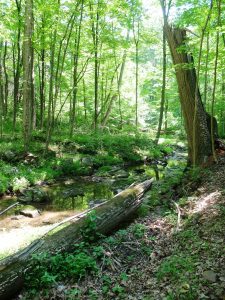
Landowner Protects Site of Early African-American Settlement
Read More
One Critical Acre Gives Shape to Preservation of Cultural Heritage
In a state of 4.492 million acres, how significant can one acre be? The answer—in the case of the William Peters property—is that a single acre is important enough for D&R Greenway to take on a most unusual role in order to preserve it. The newly preserved Peters site opens the way for a trail that will draw attention to a nearly forgotten settlement: Honey Hollow, in Hopewell Township.
 William Peters’ stone house along Church Road, between Washington Crossing State Park and Mercer County’s Ted Stiles Preserve at Baldpate Mountain, dates to General George Washington’s historic river crossing. A smaller-scale water crossing brought the
William Peters’ stone house along Church Road, between Washington Crossing State Park and Mercer County’s Ted Stiles Preserve at Baldpate Mountain, dates to General George Washington’s historic river crossing. A smaller-scale water crossing brought the
possibility of preservation of the Peters property to the forefront.
Former D&R Greenway Board Chair Alan Hershey was reconnoitering along Fiddler’s Creek while designing the southeastern section of the Fiddler’s Creek Preserve trail. Alan recalls, “The existing hunters’ bridge was inadequate and would become dangerous. I suggested to Mercer County that we acquire a sliver of land from Mr. Peters so we could bend the route of the trail to the stone abutments of the old bridge on Honey Hollow Road.”
Mercer County began discussions with the landowner, but they reached an impasse.
That was when D&R Greenway agreed to step in, taking on the not-unusual role as preservation facilitator—but with the atypical responsibility of acting as seller’s representative. With Trustee Christopher DeGrezia of law firm Drinker Biddle representing Mr. Peters, agreement was reached for the County to acquire his one acre in November 2016.
D&R Greenway Vice President Jay Watson explains why D&R Greenway decided to get involved. “Many people in the preservation community tend to focus on preserving large tracts of land, but we cannot miss the opportunity to have that small transaction that makes a critical link or preserves a unique opportunity or habitat.”
Adding one acre to the Baldpate Mountain Preserve will enable the historic, abandoned Honey Hollow Road to be connected to the trail system. The old stone bridge abutments will be left as a visible link to the past, although a modern, sturdy bridge will actually carry the new trail over the creek. There are now 12 miles of trails in the Baldpate Preserve, and 2 miles in the neighboring Fiddler’s Creek Preserve.
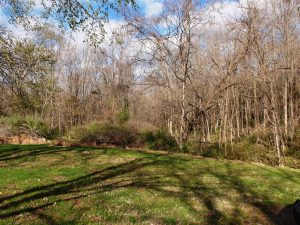
Honey Hollow Road, vacated in 1944, was once the main thoroughfare for the settlement of Honey Hollow, which exists today only on old maps and as remnant building ruins hidden in the mountain’s woods. The road went from Church Road (named for a now-vanished church) up the side of what was then called Canoe Mountain, to the ridgetop where it met Pleasant Valley Road.
Folklore implies that Honey Hollow was the home of “free Blacks” beginning in the late 19th century, remaining vital until the 20th century. Henry Charlton Beck wrote of encountering Honey Hollow’s ruins, “broken walls with trees and brambles growing from the inside,” in his 1936 book, Fare to Midlands (republished in 1962 as The Jersey Midlands). Beck reported on his encounter with one Andy Williams, “a colored man” who had moved from “up the mountain” to farm on the edge of the State Park. According to Beck, Andy Williams recalled, “There was quite a settlement of colored people all in the Hollow there. Sure, they owned the places they lived in but they just moved away and left ’em when farmin’ got too hard or they want to be in the city too strong.” Other traditions (also duly noted by Beck) suggest that moonshiners took advantage of the thick woods to install stills in the ruined houses.
Who were the residents of the Hollow and what is the real explanation for the abandonment? And what was life like for its residents during the decades that it flourished? Mercer County recently engaged Hunter Research to perform historical and genealogical research to separate out fact from lore and discover more about the story of Honey Hollow.
“We have heard the lore of this settlement for a long time and engaging Hunter Research will provide provenance for a unique story on the mountain. “It is our collective hope to provide interpretive signage explaining this unique community and diversify the stories told in our landscape,” says Jay.
“The richness of Mercer County’s history cannot be overstated,” said Mercer County Executive Brian Hughes, “and it’s truly exciting to discover the heritage of this settlement and its people. Our ultimate goal is to share the story of these early settlers and how they helped shape this great county.”

Multi-Generational Farm Family Creates Income Through Preservation, Not Development
Read More
Rawlyk Family Farm Preserved
by Bill Rawlyk, Director of Land Preservation
D&R Greenway Land Trust
When the preservation of our farm closes this year, it will be the 80th year that my family has owned these 50 acres and the 4th generation of Rawlyks to operate this land as a working farm. The land was first farmed in the 1920’s by my grandparents, then by my dad and me. The 4th generation, my sister’s children – Christian, 15 and Julie, 8 – are growing up while visiting and working on the farm.
My grandparents on my father’s side, William and Vera, emigrated as teenagers from the Ukraine through Ellis Island to New York City just before the First World War. They worked for many years to save up money to buy the land in 1926 for $6,600.
 When they first owned the farm my grandfather plowed the fields with horses. He died in 1933 at age 39, leaving his wife alone on the farm to raise their 4 year old son (my dad, Stephen). The farm at that time included an orchard and dairy operation. They produced a variety of crops, grew or raised much of their food, and were remarkably self-sufficient. My dad even owned an airplane and had an airstrip on the property in the 1940’s.
When they first owned the farm my grandfather plowed the fields with horses. He died in 1933 at age 39, leaving his wife alone on the farm to raise their 4 year old son (my dad, Stephen). The farm at that time included an orchard and dairy operation. They produced a variety of crops, grew or raised much of their food, and were remarkably self-sufficient. My dad even owned an airplane and had an airstrip on the property in the 1940’s.
However, over the years, the type of farming needed to adapt to serve different economic needs. After WWII, the farm was converted to grain and large-scale egg production with more than 30,000 chickens. In the late 1970’s we began growing sod to supply landscaping needs for New Jersey’s burgeoning development economy. However, the need to adapt to these changing markets required a large investment of resources. During that time, part of the original 118 acres were subdivided and sold to support the expenses of ongoing farming. Our family continued to work hard to maintain our rural lifestyle and to keep the remainder of the farm, the very land that we are preserving today.
It was from this experience – playing as a kid in the woods and fields, seeing the broad horizon from the seat of a tractor, harvesting corn in the fall, watching the sunsets, the fireflies, the changing seasons and the wildlife – that the land became part of me. Our family’s history is built on 80 years of experiences with farm dogs and cats, cows and horses, tractors stuck in the mud, neighbors working together during the Great Depression. These experiences and stories tied me and my sister to the land and our own family history.
Seeing the property cut in half in order to fund our survival as a farm family made me question how this might have been done better. I spent years searching for another way, one that would preserve both the family and our land. In working with D&R Greenway Land Trust, I found the solution first hand as I worked with other landowners to permanently protect their properties.
Our Family’s Pathway to Preservation
Just like the many families I work with in my role as Director of Land Preservation for D&R Greenway Land Trust, my own family had to be educated about our options. The opportunity to preserve our land and our lifestyle had changed significantly since the 1970’s when we had no other choice but to sell land for houses.
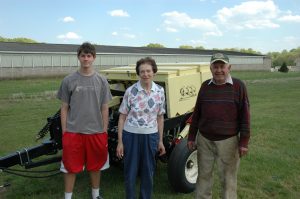 The entire family had to be brought together to decide the fate of the land. Four generations of history with our property provided us all with strong ties to our community. My father really did walk through blizzards to a one room school house about one mile from the farm (it’s still there). My mom moved from the nearby town to the farm when my parents married in 1950. She raised my sister and me while doing more than her share of the farm work and bringing in extra income from another job, as many farm families do. One of her favorite farm stories is about the thousands of chickens that we raised outdoors, fed from the back of a feed truck. Every morning the chickens would mistake the school bus for the feed truck and flood into the road, completely stopping traffic. How many Rawlyks did it take to get the chickens out of the road? All of us.
The entire family had to be brought together to decide the fate of the land. Four generations of history with our property provided us all with strong ties to our community. My father really did walk through blizzards to a one room school house about one mile from the farm (it’s still there). My mom moved from the nearby town to the farm when my parents married in 1950. She raised my sister and me while doing more than her share of the farm work and bringing in extra income from another job, as many farm families do. One of her favorite farm stories is about the thousands of chickens that we raised outdoors, fed from the back of a feed truck. Every morning the chickens would mistake the school bus for the feed truck and flood into the road, completely stopping traffic. How many Rawlyks did it take to get the chickens out of the road? All of us.
In recent years we have had to face other economic and family issues. My dad was ready to retire from active farming, and my mother was dealing with health issues. They both wanted to ensure the future of our family and our farm.
Because of my position at D&R Greenway Land Trust, I could not work through D&R Greenway to preserve our land. Instead, my family worked independently with the New Jersey Green Acres Program. The State is assembling a Greenway of preserved lands along the entire Lockatong Creek. Our farm’s location in the headwaters made our property desirable for acquisition.
Ultimately we decided on a sale of most of our farm to the State at a bargain sale price. My family accepted about 25% less than full market value for our land. The contribution that we made to the preservation of the property through a reduction in price qualifies as a tax deductible donation. The result is that we pay less in taxes and realize a better net return than we would have from a traditional development sale.
Next Steps: Perpetual Stewardship of the Land
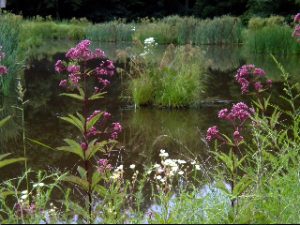 My particular interest was in seeing our land managed to enhance wildlife habitat, and to protect endangered species and migratory birds. These goals are consistent with the State’s goals; however, the State does not have sufficient staff resources for this type of active management and looks for experienced, dependable partners. After the acquisition details were complete, the solution was for my family, in consultation with the State, to identify a nonprofit organization to enter into a stewardship partnership with the State through a Management Agreement.
My particular interest was in seeing our land managed to enhance wildlife habitat, and to protect endangered species and migratory birds. These goals are consistent with the State’s goals; however, the State does not have sufficient staff resources for this type of active management and looks for experienced, dependable partners. After the acquisition details were complete, the solution was for my family, in consultation with the State, to identify a nonprofit organization to enter into a stewardship partnership with the State through a Management Agreement.
Our family trusted D&R Greenway Land Trust to take on this role. D&R Greenway is well established and has skilled staff that can manage the property’s sensitive resources. D&R Greenway has a proven track record of over 140 preserved properties and significant land holdings under active stewardship. A Management Plan was developed to include a Natural Resources Inventory and long term goals that include ecological habitat management, hunting for the purpose of protecting biodiversity, education and public access trails.
My family was willing to make a donation of $25,000 to D&R Greenway’s Stewardship Endowment to ensure that the land would be properly cared for in perpetuity. Too often sensitive lands are preserved with no plan or endowment and the very things that everyone sought to preserve can’t be maintained, and are therefore lost. We understood that this endowment was a good investment that would ensure the proper care of the property. We also understood the many costs and responsibilities involved in long term stewardship for the land trust. When you consider that perpetuity is a long time, this one-time investment was a huge bargain. It was our contribution to the ultimate preservation of the land.
The Real Value of this Partnership
The successful preservation projects that actually get completed are usually a well crafted balance between the benefits to the landowner and the public.
On my family’s farm, the balance was met. When we sold the farm, we realized a total return – taking into consideration purchase price, tax benefits, and time value of dollars – similar to that which a developer would have given us and we got it faster and with fewer up front costs. Equally important, we can all still enjoy the land in its current condition, along with the rest of the public. With a developer it would be off limits to everyone but a few homeowners.

The final preservation solution ensures that wildlife habitat will be enriched and the entire community will benefit through recreation, education and protection of the forest and of water quality in the Lockatong Creek. D&R Greenway can benefit other landowners by using the property as a teaching example to demonstrate management of grassland habitat. My family was awarded a grant from the New Jersey Landowner Incentive Program (LIP) to convert 45 acres of sod field to native warm season tall grass prairie, providing habitat for endangered grassland birds. In addition, the LIP program and Natural Resource Conservation Service approved and funded design of a 2-acre constructed wetland along the lower edge of the fields bordering the woods. This will allow an increase in the emergent wetland on the property and provide high quality habitat for vernal pond species, such as wood frogs, spotted salamanders, and spotted turtles as well as other wildlife such as shore birds, wood ducks, and many others.
The work that I do with landowners at D&R Greenway Land Trust will benefit from my own personal experience. In the end, my family chose preservation over development to fund my parent’s retirement while protecting the land we love. My mother summed up our family values when she noted that the family history will stay alive as long as the land is there – and her grandchildren will be able to experience the history and connection to the land that is so important to all of us. The entire family is pleased and proud that we could contribute our part to help sustain the quality of life for everyone who lives in central New Jersey.
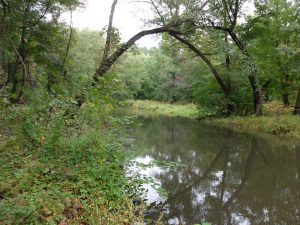
Developer Donates Land to Expand Greenway
Read More
A Living Example of Land for Life
Pretty as a picture, six lushly wooded acres line a placid stretch of the Millstone River in Cranbury Township. The floodplain, thick with sweet gum, pin oak and red maple trees, mirrors the verdant landscape on the opposite bank in East Windsor Township. A bald eagle circles silently overhead; its reflection flickers on the river’s surface while fish shimmer in the water’s depths. It is the kind of place ideal for stopping to contemplate the complex web of nature from the uncomplicated, unceasing perspective of the river.
This hidden haven, tucked below Highway 535 (Old Trenton Road), has now been preserved for the public to enjoy. Princeton Land Partners, a private landowner, donated the six acres to D&R Greenway Land Trust, which will eventually convey the land to Cranbury for connection to the township’s greenway. East Windsor Township has preserved open space directly across the river, creating a contiguous protected landscape.
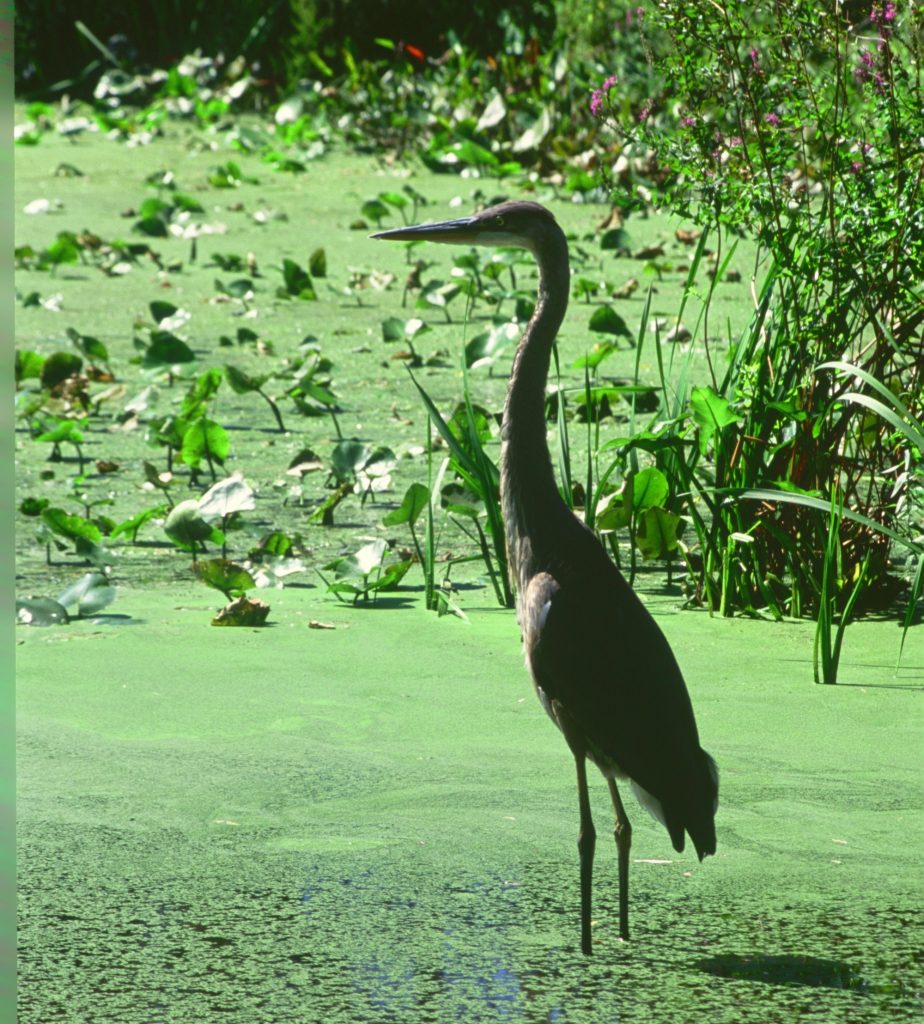 Within the forested landscape are floodplain forest trees, as well as open areas where specialized wetland wildflowers thrive, such as the bright red Cardinal flower, the stately Joe Pye Weed, ebullient pink swamp mallow (hibiscus), and the hidden yellow heads of sweet flag. The river, whose character in other places is anything but tranquil, is slow enough here that Great Blue Herons forage in shallows along the banks.
Within the forested landscape are floodplain forest trees, as well as open areas where specialized wetland wildflowers thrive, such as the bright red Cardinal flower, the stately Joe Pye Weed, ebullient pink swamp mallow (hibiscus), and the hidden yellow heads of sweet flag. The river, whose character in other places is anything but tranquil, is slow enough here that Great Blue Herons forage in shallows along the banks.
In addition to its value for wildlife habitat and recreation, the site protects water quality. The forested floodplain buffers stormwater’s effects on the Millstone, and more than half of the property is a designated wellhead protection zone for a public water supply.
“We often talk about the value of land preservation to protect water quality,” shares Linda Mead, D&R Greenway President & CEO. “This site is a living example that speaks to our founding values of protecting Land for Life.”
The owners approached D&R Greenway with the opportunity to preserve the property. Landowners seeking preservation, even those whose ultimate goal is public access or ownership, often seek to take advantage of the efficiencies that a nonprofit offers compared with a public entity, which may be less nimble in its decision-making and funding.
With the site’s triple conservation value for wildlife, water and people, accepting the offer to preserve the site was a no-brainer for D&R Greenway.
The decision was easy—but the preservation process was not without its challenges. With the site came a unique headache: how to remove the mass of non-hazardous construction debris (bricks and such) that had been historically dumped into the woods by illegal trespassers. The donor agreed to pay for its removal, but the dump’s location at the bottom of a steep drop precluded truck access from Highway 535 above. Obtaining access to the site from a neighboring site became a year-long project in itself—one accomplished only after a chance reading of an obituary yielded the key information that enabled D&R Greenway to locate the owner and negotiate the necessary permission for a contractor to enter the site and clean it up.
Although the site’s location on a floodplain would not permit development under current law, preserving it will ensure that it will stay undeveloped even if the laws change.
For the foreseeable future the site will be a necessary connection to link pieces of land into a continuous greenway and a future trail system.
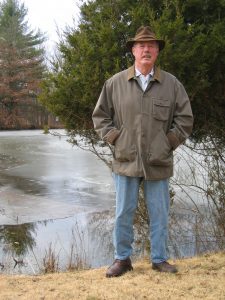
Company Divests Land and Enables Community Conservation
Read More
The Doerler family is well-known in our area for their love of the land. As noted landscapers, their mission and passion is to enhance and sustain the beauty of central New Jersey’s residential and commercial landscapes. Their nurseries have provided the plantings that have graced many properties throughout our region.
Bill Doerler, founder of Doerler Landscapes, discovered that some of the company’s agricultural land, which had supported a portion of his nursery stock and some office space, was no longer required for the businesses. While divesting the company of this unneeded asset made good sense, Bill wanted to do so in a manner that would allow the land he had cultivated so carefully for so many years to continue offering benefits to the public – if not by providing superior nursery plantings, then in some other way.
D&R Greenway’s professional staff listened to and worked with Bill and other family members to develop a preservation plan that would achieve Bill’s goals. A bargain sale of 18 acres of land was negotiated. This land, consisting of woodlands and wetlands, is adjacent to other preserved lands in the area, including Terhune Orchards, Shipetaukin Woods and Pyne Woods. A small parking area already present on the property will provide public access to a planned trail network linking all these properties. One of three existing structures, including an enclosed barn, could eventually be converted into a nature center.
Through the bargain sale, Bill was able to realize income and tax benefits, while ensuring that his land would remain productive and useful to the public.
Bill Doerler commented “It was important to me that my land continue to enhance the public’s relationship with the natural world. Now, instead of providing plants and trees to people to beautify their gardens, people can come and visit the land, to enjoy the beauty of trees and plants in their natural state.”
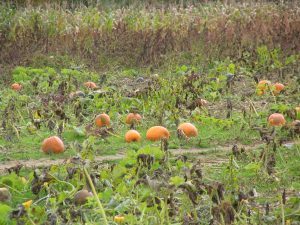 Agricultural Easement Protects Beloved Local Farm
Agricultural Easement Protects Beloved Local Farm
Read More
Windsor U-Pick Farms
It just wouldn’t be Halloween without Windsor U-Pick. The 51-acre farm is a beloved institution, especially in the fall – with pumpkins, hayrides and scary adventures for families and friends to share. Schoolchildren are brought here on field trips and the owners Wayne Kalinowski and Paul Keris are especially accommodating to children with special needs. The owners were committed to preserving their land and their faming heritage and turned to D&R Greenway for help in ensuring they would have the financial resources to do so.
D&R Greenway structured a solution that placed the majority of the property under a farmland preservation easement through Mercer County. A conservation easement overlay was placed on the wooded section of the property that buffers 1,500 feet of the Assunpink Creek, extending the Assunpink Greenway and providing for trail linkages to be established the future.
As a result, West Windsor and Washington Townships were able to maintain a significant part of their rural heritage. Residents of the region will be able to continue to enjoy family fun and locally grown produce at Windsor U-Pick.
According to Wayne Kalinowski the mission of Windsor U-Pick is agro-tainment. “We mix traditional agricultural activities with interactive fun – and create an opportunity for visitors to enjoy farming and the land. By preserving our land, we can continue to provide this experience to our customers.”

